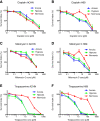Effects of hypoxia on human cancer cell line chemosensitivity
- PMID: 23829203
- PMCID: PMC3707755
- DOI: 10.1186/1471-2407-13-331
Effects of hypoxia on human cancer cell line chemosensitivity
Abstract
Background: Environment inside even a small tumor is characterized by total (anoxia) or partial oxygen deprivation, (hypoxia). It has been shown that radiotherapy and some conventional chemotherapies may be less effective in hypoxia, and therefore it is important to investigate how different drugs act in different microenvironments. In this study we perform a large screening of the effects of 19 clinically used or experimental chemotherapeutic drugs on five different cell lines in conditions of normoxia, hypoxia and anoxia.
Methods: A panel of 19 commercially available drugs: 5-fluorouracil, acriflavine, bortezomib, cisplatin, digitoxin, digoxin, docetaxel, doxorubicin, etoposide, gemcitabine, irinotecan, melphalan, mitomycin c, rapamycin, sorafenib, thalidomide, tirapazamine, topotecan and vincristine were tested for cytotoxic activity on the cancer cell lines A2780 (ovarian), ACHN (renal), MCF-7 (breast), H69 (SCLC) and U-937 (lymphoma). Parallel aliquots of the cells were grown at different oxygen pressures and after 72 hours of drug exposure viability was measured with the fluorometric microculture cytotoxicity assay (FMCA).
Results: Sorafenib, irinotecan and docetaxel were in general more effective in an oxygenated environment, while cisplatin, mitomycin c and tirapazamine were more effective in a low oxygen environment. Surprisingly, hypoxia in H69 and MCF-7 cells mostly rendered higher drug sensitivity. In contrast ACHN appeared more sensitive to hypoxia, giving slower proliferating cells, and consequently, was more resistant to most drugs.
Conclusions: A panel of standard cytotoxic agents was tested against five different human cancer cell lines cultivated at normoxic, hypoxic and anoxic conditions. Results show that impaired chemosensitivity is not universal, in contrast different cell lines behave different and some drugs appear even less effective in normoxia than hypoxia.
Figures



References
-
- Durand RE, Raleigh JA. Identification of nonproliferating but viable hypoxic tumor cells in vivo. Cancer Res. 1998;58(16):3547–3550. - PubMed
-
- Evans SM, Joiner B, Jenkins WT, Laughlin KM, Lord EM, Koch CJ. Identification of hypoxia in cells and tissues of epigastric 9L rat glioma using EF5 [2-(2-nitro-1H-imidazol-1-yl)-N-(2,2,3,3,3-pentafluoropropyl) acetamide] Br J Cancer. 1995;72(4):875–882. doi: 10.1038/bjc.1995.427. - DOI - PMC - PubMed
Publication types
MeSH terms
Substances
LinkOut - more resources
Full Text Sources
Other Literature Sources

